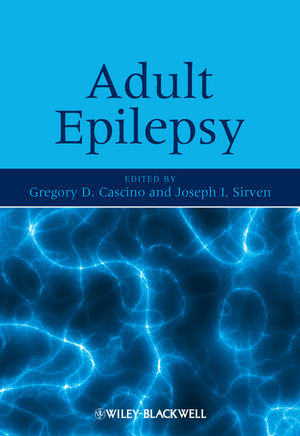
Adult Epilepsy
Wiley-Blackwell (Verlag)
978-0-470-74122-1 (ISBN)
- Titel ist leider vergriffen;
keine Neuauflage - Artikel merken
Designed to provide a comprehensive but accessible introduction to epilepsy and seizure disorders, Adult Epilepsy provides state-of-the-art information in a concise format useful to a wide audience, from neurology residents to epilepsy fellows and practitioners. This illustrated guide to the assessment, diagnosis, and treatment of epilepsy is a valuable resource enabling clinicians to stay on top of the latest recommendations for best practice.
Gregory Cascino is a Professor of Neurology and principal investigator at the Mayo Clinic, in the National Institutes of Health funded study Epilepsy Phenome Genome Project (EPGP) beginning in 2007. He is interested in the care and management of patients with seizures and epilepsy and the evaluation of patients for surgical treatment of epilepsy. Joseph Sirven is a Professor of Neurology at the Mayo Clinic and chair of neurology at Mayo Clinic Arizona. His main interests are in Epilepsy and Seizure Treatments in Adults and Children (particularly older adults), Epilepsy Surgery, Electroencephalography, Investigational Antiepilepsy Drugs, Status Epilepticus, Vagal Nerve Stimulator, Ketogenic Diet.
List of contributors xiii Preface xvii 1 Introduction: epilepsy 1 Gregory D. Cascino 1.1 Epilepsy care: beginnings of observation and recognition 1 1.2 Epilepsy care: initial understanding and treatment 2 1.3 Epilepsy care: the Mayo Clinic 3 Section 1 Pathophysiology and epidemiology of seizures and epilepsy 7 2 Seizure and epilepsy syndromes classification 9 Jerry J. Shih 2.1 Introduction 9 2.2 The classification of epileptic seizures 9 2.3 Conclusion 16 3 Epidemiology of seizure disorders 19 Joseph I. Sirven 3.1 Incidence and prevalence of epilepsy 19 3.2 Incidence and prevalence of acute symptomatic seizures 21 3.3 Looking beyond epidemiology: the state of epilepsy care in the United States 22 3.4 Risk factors for epilepsy 23 3.5 Conclusion 24 Section 2 Diagnostic evaluation 27 4 The role of routine scalp electroencephalography 29 Terrence D. Lagerlund and Gregory A. Worrell 4.1 Introduction 29 4.2 Clinical application of EEG 30 4.3 Scalp EEG recording methods 32 4.4 Activation procedures 33 4.5 Interictal discharges correlated with epilepsy 34 4.6 Epileptic syndromes and the role of EEG 42 4.7 Conclusions 45 5 Neuroimaging in epilepsy 49 Gregory D. Cascino 5.1 Introduction 49 5.2 Magnetic resonance imaging 50 5.3 Functional neuroimaging 57 6 Video-EEG monitoring data 67 Elson L. So 6.1 Introduction 67 6.2 Pre-monitoring evaluation and preparation 67 6.3 Management during monitoring 68 6.4 Discharge management 78 Acknowledgments 78 7 Etiologies of seizures 83 Katherine H. Noe and Korwyn Williams 7.1 Introduction 83 7.2 Acute symptomatic seizures 83 7.3 Febrile seizures 86 7.4 Unprovoked seizures 87 8 The evaluation of nonepileptic paroxysmal events 99 Joseph F. Drazkowski and Matthew Hoerth 8.1 Introduction 99 8.2 Syncope 101 8.3 Transient ischemic events (TIAs) 103 8.4 Transient global amnesia (TGA) 104 8.5 Movement disorders 105 8.6 Sleep disorders 105 8.7 Psychogenic nonepileptic seizures (PNESs) 107 8.8 Summary 108 Section 3 Principles of medical management 113 9 Mechanisms of action of antiepileptic drugs 115 Jeffrey W. Britton, Tarek M. Zakaria, and Eduardo Benarroch 9.1 Introduction 115 9.2 Treatment of epilepsy 116 9.3 Excitatory mechanisms targeted by AEDs 118 9.4 Inhibitory mechanisms targeted by AEDs 120 9.5 Mechanism of action-specific drugs 122 9.6 Conclusions 126 10 Antiepileptic drugs: pharmacology, epilepsy indications, and selection 131 Jeffrey W. Britton and Julie Cunningham 10.1 Introduction 131 10.2 AED selection 132 10.3 Generic AED therapy 145 10.4 The AEDs: summary of clinical use, pharmacokinetics, and efficacy 147 Section 4 Generalized epilepsies 171 11 Idiopathic generalized epilepsies 173 Raj D. Sheth 11.1 Overview of the generalized epilepsies 173 11.2 Introduction 174 11.3 Differentiating generalized seizures from partial seizures 175 11.4 Clinical and EEG characteristics of generalized seizures 176 11.5 Generalized epilepsy syndromes 178 11.6 Treating generalized seizures 180 11.7 Treatment algorithm 180 11.8 Prognosis/outcomes 182 12 Symptomatic generalized epilepsies 183 Katherine C. Nickels and Elaine Wirrell 12.1 Introduction 183 12.2 Infantile onset syndromes 184 12.3 Childhood onset syndromes 190 12.4 Symptomatic generalized epilepsy syndromes of known cause 196 Section 5 Partial epilepsies 211 13 Overview of diagnosis and medical treatment of partial epilepsies 213 Joseph I. Sirven 13.1 Diagnosis and evaluation 213 13.2 Electroencephalography (EEG) 214 13.3 Imaging 215 13.4 Treatment and management 216 13.5 Which patient should be treated with antiseizure drugs? 216 13.6 Evidence-based guidelines 218 13.7 How well do seizure medications work? 218 13.8 Conclusion and summary 219 14 Medial temporal lobe epilepsy 221 William O. Tatum IV 14.1 Introduction 221 14.2 Functional neuroanatomy of the temporal lobe 222 14.3 Pathology 223 14.4 Differential diagnosis 225 14.5 Diagnosis 227 14.6 Concluding statements 239 15 Substrate-directed epilepsy 247 Gregory A. Worrell 15.1 Intractable partial epilepsy 247 15.2 Epilepsy surgery 248 15.3 Localization of the epileptogenic zone 250 15.4 Lesional MRI (or substrate-directed epilepsy syndromes) 253 15.5 Functional neuroimaging and intracranial EEG 253 15.6 Symptomatic partial epilepsy 258 15.7 Non-lesional MRI (non-substrate-directed partial epilepsy) 261 15.8 Non-lesional temporal lobe epilepsy (surgically remediable syndrome?) 262 15.9 Surgical advances 263 16 Non-substrate-directed partial epilepsy 271 Korwyn Williams and Katherine H. Noe 16.1 Introduction 271 16.2 Genetic or IPE syndromes 272 16.3 Medically refractory non-substrate-directed partial epilepsy 272 16.4 Conclusions 279 17 Surgical treatment 285 Cheolsu Shin 17.1 Introduction 285 17.2 The process of presurgical evaluation 286 17.3 Intracranial monitoring 287 17.4 Surgical procedures 289 17.5 Conclusion 294 Index 297
| Verlagsort | Hoboken |
|---|---|
| Sprache | englisch |
| Maße | 173 x 251 mm |
| Gewicht | 726 g |
| Themenwelt | Medizin / Pharmazie ► Medizinische Fachgebiete ► Neurologie |
| ISBN-10 | 0-470-74122-8 / 0470741228 |
| ISBN-13 | 978-0-470-74122-1 / 9780470741221 |
| Zustand | Neuware |
| Haben Sie eine Frage zum Produkt? |
aus dem Bereich



